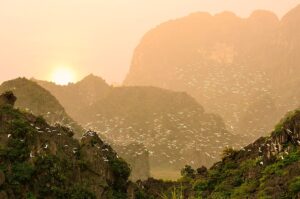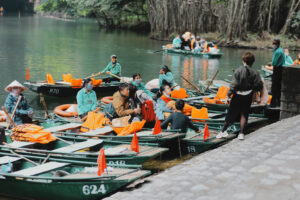Location
The Hong River (Sông Hồng), a tributary of the famed Red River, flows through the mountainous terrain of the Ninh Binh province located 93 km from the Vietnamese capitol of Hanoi. While limestone and gypsum sediments have largely formed the landscape, over the years the Hong River has created rich alluvial plains and shaped the province into a stunningly beautiful land. Ancient rice fields, rampant tropical forests, broad meandering streams and the abrupt eroded limestone precipices (Karsts) reaching skyward make up the mosaic that Ninh Binh is today.
From the vast tracts of primal forests on its western borders to the South China Sea on its southeastern coast, four “special-use” areas make up this region. The iconic Cuc Phuong State Park and Animal Rehabilitation Center lies to the west, Van Long Wetland Nature Reserve to the northwest, the UNESCO-recognized Hoa Lu-Trang An Landscape Complex to the southwest and the unique Coi Noi-Kim Son coastal protection forest to the south.
The Ninh Binh coastline is only 18 km long, but it is abundant with marine life and dotted with small coral islands such as Con Noi (Cồn Nổi) and Con Mo (Cồn Mờ), which are recognized as important global biosphere preserves by UNESCO
Weather
Ninh Binh experiences a humid subtropical climate with hot summers and cool winters. The average temperature during summer months (May to September) is around 30°C (86°F), while in winter (November to March), the average temperature is around 15°C (59°F). The rainy season is from May to October, with the highest precipitation occurring in August and September. Flooding can occur during this period. Ninh Binh is also prone to typhoons, especially from August to October, and travelers should take caution and follow local weather advisories.
Generally speaking, April to May and October to November are seen as the peak travel periods. Others prefer the early Autumn period when temperatures are cooler and the rains have yet to begin. That being said, many of Ninh Binh religious and cultural festivals happen during the Lunar Spring (Jan-March). If your interest is the local culture and religion this is a great time to see the pageantry and devotion that Vietnamese display towards their long and unique heritage.
The cooler winter period is for many a pleasant time for long treks or physically demanding activities. However, whenever you visit, you can be assured a warm Ninh Binh welcome and a unique and enjoyable experience.
It’s worth noting that due to the COVID-19 pandemic, travel restrictions and advisories were in place and affected the timing and feasibility of travel to Ninh Binh or Vietnam in general. Thankfully, that time is now in the past but due to the wilful climate in this part of the world, travelers should always check the latest information and guidelines from the government and health authorities before planning a trip.
Politics
Ninh Binh contains two large regional cities, Ninh Binh City (TP Ninh Binh) and Tam Diep city (TP Tam Diep). Ninh Binh City is the Provincial capital of the province of the province of the same name which itself is further divided into six districts – Hoa Lu, Gia Vien, Nho Quan , Yen Khanh, Kim Son and Yen Mo.
Each district is further divided up into local ruling bodies called Communes. The Communes are responsible for local matters and provide input to the District government on larger issues, all under the auspices of the powerful Central Committee. Vietnamese politics are complex and differ from many Western structures.
Unless you have a specific interest sanctioned by the Central government, travelers are advised to steer clear of political discussions and protests. Vietnam is an independent Socialist country with a diverse population of some 100 million and the huge burden of self-rule, modernization and economic stability after centuries of colonialism, warfare and social upheaval.
The only politics a traveler should be interested in is how to behave and where to spend their money. If tourists come for prostitution or drugs (both of which are heavily prohibited by Vietnamese law) then a culture will develop around those things. Comparatively new to the international tourist trade, your overriding concern should be to encourage conservation, politeness, tolerance and honesty. Leave internal Vietnamese politics to the Vietnamese.
Vietnam is a beautiful, exotic and spectacular country with friendly people, a world famous cuisine, great beaches, lush rain forests, unique fauna and flora, fascinating tribal groups and enough adventure destinations to satisfy even the most jaded of travelers.
Demographics
In 2019, the population of Ninh Binh province was around 1 million people, occupying an area of 1,387 km², resulting in a population density of approximately 708.5/km². Ninh Binh City and Tam Diep are the two major cities, with populations of around 130,000 and 70,000, respectively. The most densely populated district is Kim Son, located on the southern coast, with around 180,000 inhabitants.
The majority of the population, accounting for 98%, are the Viet Kinh people, who are the predominant ethnic group in Vietnam. There are also 23 tribal groups residing in or near Ninh Binh, including the Dao, Hoa, Hmong, Mường, Tày, and Thai people. While you often see tribal people in the urban areas, many have adopted a modern lifestyle and may not be readily distinguishable from the general population.




